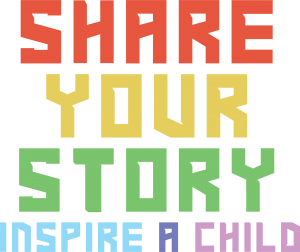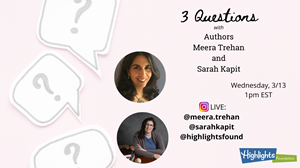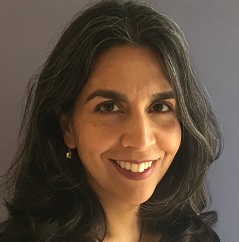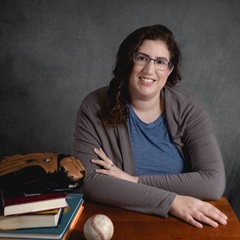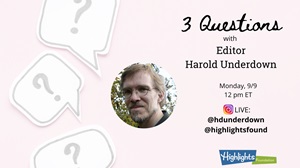Full Transcript:
Cat:
A big hello to the Highlights Foundation family. We’re so happy to have you here with us. For those that may not know me. I’m cat Galeano, my pronouns are she/her, and I’m the social media manager for the Highlights Foundation, joining you from Westchester, NY, on the traditional lands of the Siwanoy people. Apart from all the fun things I get to do at the Highlights Foundation, I am also a writer and a reader who is very excited to welcome back our friends and faculty Meera Trehan and Sarah Kapit who will be teaching the upcoming two night mini Multiple Narrator Novels, taking place next week March 19th and 21st.
Before we dive in, I just want to remind our viewers that joining in on any Highlights Foundation sessions, to do so with no hate, no harm and no harassment of any kind.
And now let’s get started. So my first question for both of you is what’s an example of a book you loved–either yours or not–that used a multiple point of views or POV’s and what did that choice do for the story for you as a reader?
Sarah:
Uh, can I go first?
Meera:
Yeah. Yeah.
Sarah:
OK, so lately in preparing for the class, I’ve been rereading a, one of my favorite dual POV YA romances. It is Tell Me How You Really Feel, by Aminah Mae Safi and I’m going to pitch it to you for–I don’t know if there are any other fellow Gilmore Girls fans out there, but I am a Gilmore Girls fan, and the pitch is basically what if Rory and Paris got together like they were supposed to? And so it is a queer feminist romance that, that’s two points of view, but I think it just works so much better that way, because you really do see both of the girls’ perspectives there really is two beautiful character arcs in one. I’ll talk about the book more in the class, but I think that’s just one example of a book that just would not work nearly as well if it was just one and I really recommend it for anyone who likes writing romances, but especially if you’re a Gilmore Girls fan like me and this pitch appeals to you.
Cat:
I’m guilty. I was typing the name of that book as you said it. So yes, and I will be calling, I will be signing up at the library for that book next. So thank you for that recommendation. Meera?
Meera:
I picked, I would think of, and I have this book actually on my desk, Dig by A.S. King, which is a multiple point of view book I want to say–and I could be wrong–there may be like seven points of view. And her, I think the most important thing in any multiple point of view book is Voice, and her ability to kind of get into different voices and different peoples’ heads, too. You know, a couple of old grandparents preparing for an Easter dinner to a ghost to teenagers working fast food to…you know, it’s just amazing and she makes these very compelling voices come together in a really compelling story. And thematically, the story just would not at all be the same as what we’re told from one point of view as well as kind of… In some ways, what seems relatively ordinary, you know, the preparation of going to an Easter dinner becomes absolutely kind of compelling. And the back story she can bring in by bringing in these multiple points of view makes it a mystery. And really, a eally moving story. So that’s what I recommend.
Cat:
I also, I also–guilty!–wrote that one down. So thank you. My next question is when you’ve chosen to write something in multiple POV’s, did it start out that way from the idea phase or did it start out another way and you revised into multiple POV’s? Can you sort of talk about a little of your process?
Meera:
Sure, I can go first with this one. So for my novel, The View from the Very Best House in Town, I don’t know if at the very beginning it started out multiple points of view but pretty early on, it started out multiple points of view and in that book. There are two kids and then there’s a house, and I had one of the kid characters–Asha–and the house for several drafts and the story just felt a little bit thin, like it wasn’t quite everything, it wasn’t quite holding together. It wasn’t quite the length I wanted. It wasn’t quite everything, and so actually just as a writing exercise, I started doing kind of some free writing from another point of view, Sam’s. And after doing that for a while, it became clear to me that that was actually like what this story was missing to feel like a whole book. So, so in my case sort of yes, but also also yes.
Cat:
I like that.
Sarah:
Oh, for me in most cases, it has been from the beginning I have the idea that, you, oftentimes for me it’s 2 characters I see. I want to write these two characters and it just it comes from me. All of my books come from ideas and characters, so it often times has come from the beginning, but occasionally it has been otherwise and I think similar to what Meera said. And right now–this is, I’m still in the drafting phase on this–but I’ve had an idea for kind of a romance novel for a long time. And I think I tried to write it and I just never got very far with it. And then suddenly, one day, I thought, oh, well, what if I wrote it in both points of views? And then it was sort of similar to what Meera said, and that unlocked it and now I’m sort of 80% there with the draft. And so just realizing that I want to do both points of views kind of helped. But I have had the other way too, where I knew from the beginning it was going to be multiple point of views.
Cat:
This is just like a personal question for both of you. Have you ever thought about writing like more than two points of views? Is that something like perhaps like in the future, you’d be like you know what? Maybe I’m up for the task.
Sarah:
Meera’s book IS 3 points of view actually.
Cat:
Guilty! I didn’t have time to read it, I’m sorry.
Sarah:
For me, I think it would be a little much to handle. I mean, I’d be interested, but I think it’s a lot of work to do so many points of view. So I’m impressed with anybody who can, but I mean. I’d be interested, but I’m cautious.
Cat:
I love that answer, thank you.
Meera:
And and I would say, I mean, I think there, every time you, there’s so much fun in adding a point of view. But every time you do add a point of view, you can kind of take away from the main storyline. And so you have to, I think, be really intentional about what you do, and I know someone who wrote a book from 31 points of view because it was a class, in each class, and and it’s published. It’s The Last Fifth Grade of Emerson Elementary, and even that got cut down to 18 points of view. So I think it can be fun to add, but it’s also always a balancing even when you’re having a lot if you don’t want to lose that main story, right?
Cat:
I feel like you could get lost, yeah, a lot quicker. So anyway, we’re,we’re down to my last question because I,I threw in just like a personal question. So this is our technical third last question as a writer the first time you wrote in multiple POV’s point of views, was there something that surprised you or something that was harder than you thought it would be?
Sarah:
Definitely it was hard to come up with a full story arc for both of them and have it, have them both have equal weight. Because, well, actually my first book is technically two points of view. But one character, one of the point of view characters is an adult. And so. He has a lot less weight than the main character. Actually doing the adult’s point point of view in a middle grade book is actually incredibly difficult. That was probably the most difficult part of that book. My debut, Get a Grip, Vivy Cohen. And so that was its own challenge. But for books where it’s more equal, figuring out a character arc for both characters that’s kind of complementary, but distinct. That definitely was the most difficult part.
Meera:
And anything for me, the good surprise is just how much fun it was and how maybe when I’m sort of a little bit tired of writing on one character’s point of view that I can still be productive on my novel working on another character, but I think the hardest thing for me is kind of what I was saying, was keeping that momentum going because you sort of want to tel–when I have multiple characters points of view, I want to tell everything from everyone’s point of view. But that can get really confusing for the reader and you can take the reader to a point where they’re really excited and they’re like, OK, what’s going to happen? And sometimes it’s great to hold off a little bit. But if you do that too much, you can really lose the momentum of the story. And so really kind of, it’s almost a puzzle and figuring out how the pieces are really going to fit together to make for the most effective reading experience, I think that’s something that when I’m writing. I have to put a lot of work into and you know, give it a lot of tries to kind of keep that right.
Cat:
I love that visual of the puzzle. I feel like that makes so much sense to me because I’m more of a visual person. So when you were talking about like the literal puzzle piercing of of how you work, I was like, oh, I’m getting it. I’m getting it. It’s coming clearer to me. Well, that’s it from me. Is there anything else you wanted to add and share for those that may or may not be showing up to class next week? Hopefully, well, it’s going to be really good.
Meera:
I’d like to say it IS really gonna be good and I took a multiple point of view writing like like did a session years ago before I ever really had thought I could do it. But I was like, oh well, this is kind of might be interesting, just to listen to and then, you know my first novel and my second novel are from multiple points of view. So I think sometimes just dipping your toe in the water can really open up, you know, the whole world the right thing, so.
Sarah:
It’s I totally agree with that and I hope that the class is inspiring to people and encourages you to just try things out, because that’s what writing is really all about.
Cat:
Well, thank you. I mean, and I second both of you and you know, there’s nothing wrong with trying something new and coming and exploring something. And even if you’re a little scared, why not come and find out a little bit? And maybe if you’re not ready to write it now, maybe you’ll sit with it and, you know, rewatch the class and and the recording. And maybe in a month from now you’ll be ready. So anyway, we invite everyone to come: if you’re scared, if you’re not scared, if you write this, if you don’t write this, we invite everyone to come. And yeah, if you’d like to learn more from Meera and Sarah, please make sure to join them for this class which is Multiple Narrator Novels, a Two Night Mini taking place March 19th and 21st. You can register on our website at highlightsfoundation.org. And lastly you can purchase Meera’s and Sarah’s books at our virtual Book Shop, powered by bookshop.org. Thank you, Meera. Thank you, Sarah, for joining us. And we can’t wait to see you online.
Sarah:
Thanks Cat.
Meera:
Absolutely.
Cat:
Thank you. Thank you so much.

